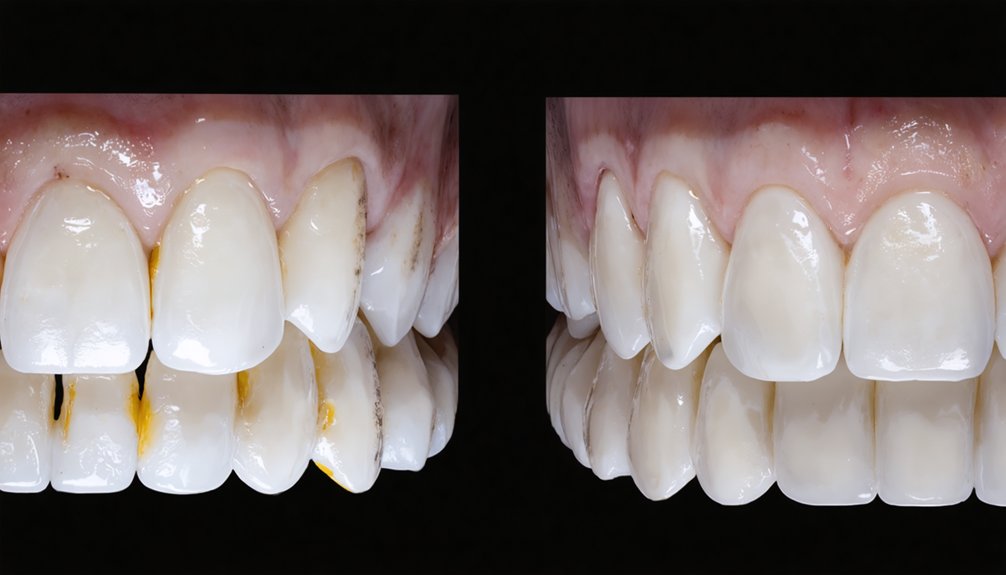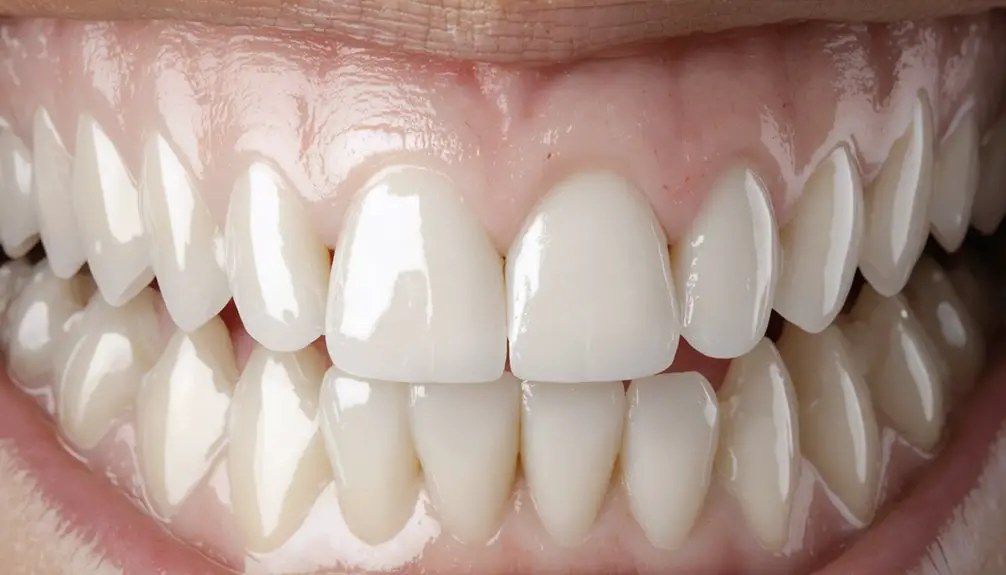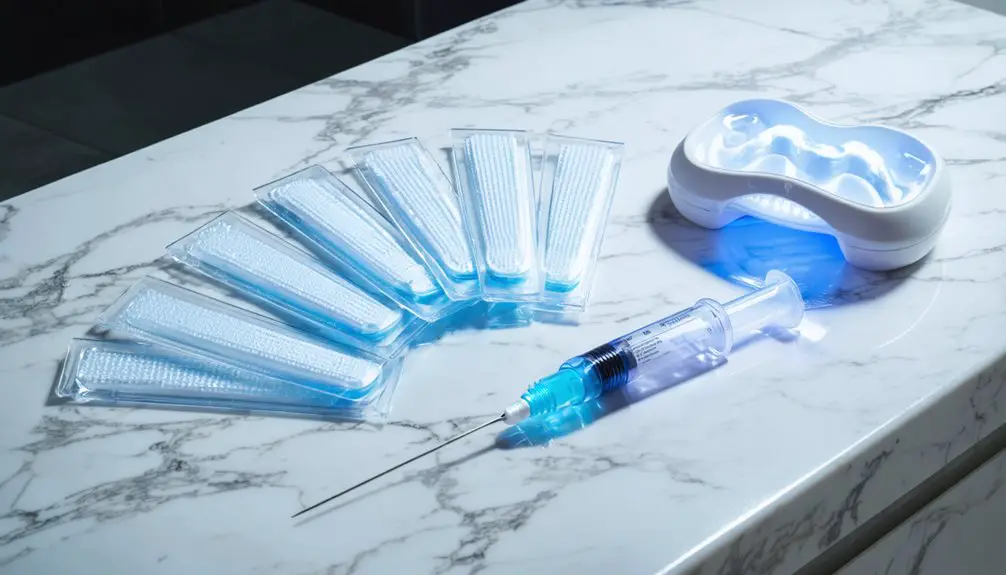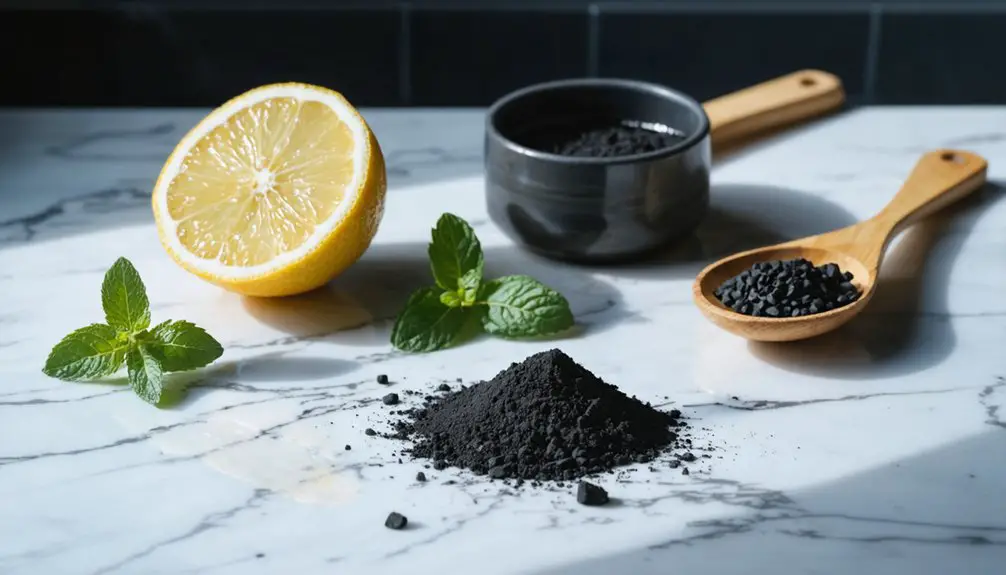Professional teeth whitening uses higher peroxide concentrations under controlled conditions, achieving 6-8 shades of improvement in a single hour-long session. You’ll find dentists provide customized treatment plans, protective barriers, and careful monitoring for maximum results lasting 6 months to 3 years. At-home options, while more affordable ($5-$150), take 4-6 weeks with 3-6 shades of improvement. Understanding the complete differences will help determine which method best suits your needs.
Key Takeaways
- Professional treatments use higher peroxide concentrations and achieve 6-8 shade improvements in one hour versus 3-6 shades over weeks for at-home options.
- Dentists provide customized treatment plans and safety monitoring, while at-home methods lack professional oversight and risk management.
- In-office whitening costs $300-$1,800 but lasts longer, compared to $5-$60 for OTC products requiring frequent repurchasing.
- Professional treatments include protective barriers and pH monitoring, reducing risks of sensitivity and uneven results.
- At-home whitening requires daily application over 4-6 weeks, while professional treatments deliver immediate results in a single appointment.
The Science Behind Teeth Whitening Methods
Although teeth whitening has become increasingly popular, the science behind it relies on a precise chemical process involving peroxide-based bleaching agents.
When you receive treatment, either hydrogen peroxide or carbamide peroxide penetrates your tooth’s enamel, releasing free radicals that break down stain molecules into smaller, less pigmented fragments.
The effectiveness of these chemical agents depends heavily on pH stability, concentration levels, and contact duration.
Professional treatments utilize higher peroxide concentrations under controlled pH conditions, while at-home methods employ lower concentrations for gradual results.
Your dentist’s in-office treatments maintain precise pH balance and chemical stability, ensuring maximum whitening potential and provide immediate visible results after just one session.
The process works at a molecular level, with the whitening agents reaching both the enamel and underlying dentin where deeper stains reside.
Advanced treatments may incorporate light activation systems to accelerate the peroxide breakdown process and enhance overall whitening results.
Time and Results: Speed Vs Gradual Progress
When considering teeth whitening options, the stark contrast between professional and at-home treatments centers on their timing and efficacy.
You’ll achieve dramatic results within an hour through professional in-office whitening, with teeth brightening up to 6-8 shades in a single session. Professional treatments can maintain whitening effectiveness for 6 months to 3 years. The speed of results depends heavily on enamel health conditions. Professional treatments deliver superior results because they use stronger bleaching agents.
At-home whitening takes a more gradual approach, requiring 1-2 weeks of consistent use for professional take-home kits, or 4-6 weeks for over-the-counter products.
Professional take-home kits brighten teeth in 1-2 weeks, while over-the-counter whitening solutions need 4-6 weeks of daily application for results.
While the treatment duration is longer, this methodical process often results in less sensitivity. You’ll need to commit to regular maintenance, as at-home results typically last 6-12 months for professional kits and 1-3 months for over-the-counter options.
Safety Measures and Professional Oversight
Because patient safety remains paramount in teeth whitening procedures, professional oversight offers essential protection through systematic safeguards and monitoring.
Your dentist will evaluate your oral health, identify potential risks, and create customized treatment plans that protect your teeth and gums. They’ll apply protective barriers and monitor gel concentrations precisely. Reading and following the product instructions carefully ensures optimal results during professional treatments. The process is safe and proven when performed by experienced dental professionals.
While at-home kits offer convenience, they lack the risk management benefits of professional supervision. You won’t receive custom-fitted trays, sensitivity protocols, or real-time adjustments during treatment.
Without proper oversight, you’re more vulnerable to enamel damage, uneven results, and gum irritation. Professional treatments utilize FDA-approved products at ideal concentrations and include thorough monitoring for side effects.
Your dentist can adjust treatment immediately if you experience sensitivity, ensuring both safety and effectiveness throughout the whitening process.
Cost Analysis: Long-Term Value Vs Initial Investment
While teeth whitening options span a wide price range, understanding the relationship between initial costs and long-term value proves essential for making an informed decision.
Professional in-office treatments command higher upfront costs ($300-$1,800) but deliver immediate, longer-lasting results. Though OTC products ($5-$60) and at-home kits ($100-$400) offer lower initial investments, their cumulative expenses can escalate due to repeated purchases and extended treatment times. Professional options tend to show faster noticeable results compared to at-home alternatives. Skilled dentists ensure even application and safer treatment outcomes through their expertise and access to high-quality materials.
While cheaper options exist, professional teeth whitening’s higher cost often proves more economical through faster, more enduring results than repeated at-home treatments.
When evaluating cost-effectiveness, consider that professional treatments often require fewer touch-ups and provide superior results through customized care.
While insurance typically doesn’t cover cosmetic whitening, the enhanced efficiency and durability of professional treatments may offset the higher initial investment, especially when factoring in the reduced need for ongoing maintenance and replacements.
Choosing the Right Option for Your Needs
How do you determine which teeth whitening method aligns with your specific needs? Consider your whitening goals, time constraints, and product preferences.
If you’re seeking dramatic results for stubborn stains, professional treatment offers up to 8 shades of improvement in a single session. Professional treatments use stronger peroxide levels for enhanced whitening power. For mild discoloration or maintenance, at-home options can achieve 3-6 shades of whitening over several weeks.
Evaluate your schedule and user experiences with dental procedures. Professional whitening requires one 1-2 hour appointment, while at-home methods demand consistent daily application. At-home treatments are more budget-friendly with most products ranging from $20 to $150.
If you have dental restorations or sensitivity concerns, consult a dentist first. They’ll assess your oral health and recommend the most suitable approach.
Remember that professional supervision minimizes risks, though at-home products offer flexibility for those preferring gradual improvement on their own timeline.
Frequently Asked Questions
Can I Eat and Drink Normally Immediately After a Teeth Whitening Treatment?
You can’t eat or drink anything except water for 2 hours post-treatment. Wait 48 hours before resuming normal diet to prevent staining and manage whitening sensitivity while your enamel recovers.
How Long Should I Wait Between Professional Whitening Treatments?
You should wait 6-12 months between professional whitening treatments for ideal safety. The recommended treatment intervals depend on your tooth sensitivity, oral health, and whitening frequency needs.
Will Whitening Treatments Affect Existing Dental Work Like Crowns or Fillings?
Whitening effects won’t damage your existing dental work, but they won’t brighten dental materials like crowns or fillings either. This can create color mismatches between your natural teeth and restorations.
Are Teeth Whitening Results Permanent, or Do They Require Regular Maintenance?
Your teeth whitening results aren’t permanent. You’ll need regular maintenance every 6 months to 3 years, depending on your whitening method, lifestyle habits, and oral hygiene routine.
Can Teenagers Safely Undergo Professional Teeth Whitening Procedures?
Professional teeth whitening is safe for teenagers if you follow key safety guidelines – dental supervision, fully erupted permanent teeth, and age restrictions (typically 15+). Prior oral health assessment is essential.
References
- https://www.veenstradental.com/blog/at-home-vs-professional-teeth-whiteningwhats-the-difference-
- https://www.fairfaxfamilydentist.com/blog/whats-the-difference-between-professional-teeth-whitening-and-at-home-kits
- https://www.dentalassociates.com/blog/professional-teeth-whitening-vs-at-home-teeth-whitening
- https://www.smileslosgatos.com/articles/professional-teeth-whitening-vs-at-home-kits
- https://www.tualatinvalleydental.com/post/professional-teeth-whitening-vs-at-home-kits
- https://www.yourdentistryguide.com/inoffice-vs-athome/
- https://www.perennialdental.com/post/professional-teeth-whitening-vs-at-home-kits-which-is-right-for-you
- https://www.panoramicdental.com/blog/at-home-vs-professional-teeth-whitening
- https://ofallondentalworks.com/professional-teeth-whitening-options/
- https://www.champaigndentalgroup.org/about-us/blog-articles/how-teeth-whitening-works-the-science-behind-brighter-smiles



